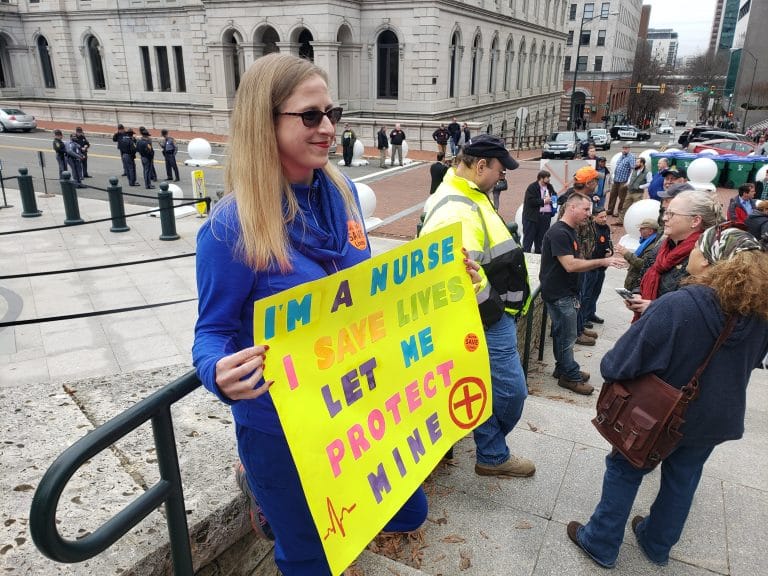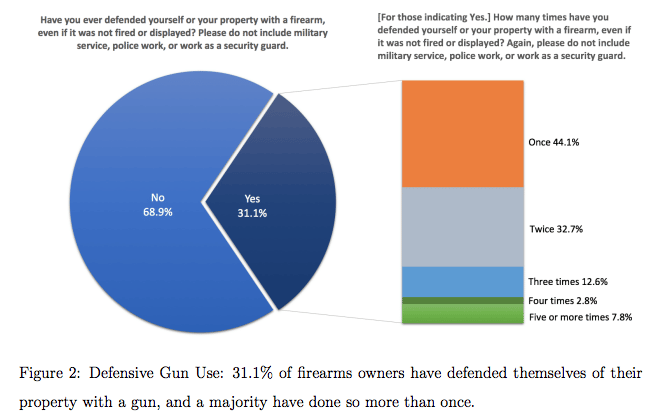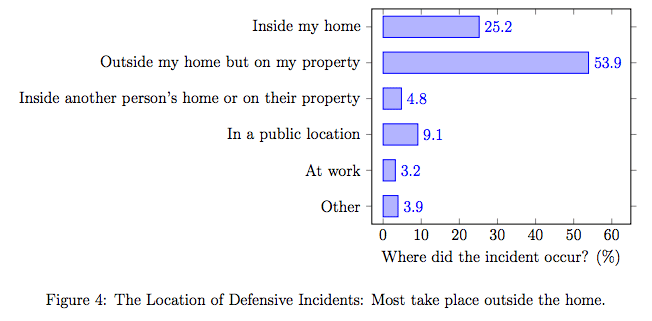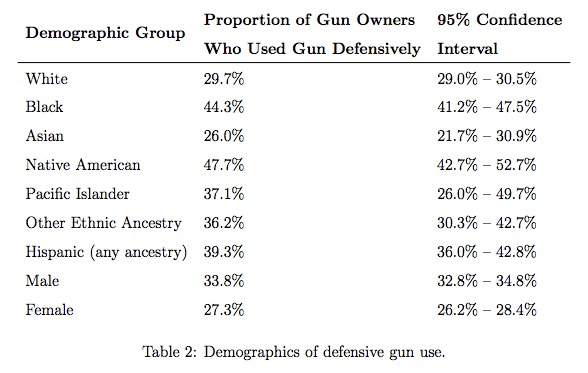The largest-ever scientific survey of gun owners found Americans used a gun in self-defense at least 1.67 million times per year. But the poll did a lot more than just count defensive uses; it also detailed how, when, and where they happened.
The National Firearms Survey, conducted by Georgetown University Professor William English, presented a ton of information on key questions surrounding guns in America. It found gun ownership is diversifying and gun carry is broadly popular. It found about a third of gun owners have owned an AR-15 or similar rifle and 50 percent have owned magazines holding more than ten rounds–key information for the legal battles over whether they can be banned.
And, of course, it also found a large number of American gun owners report using their guns to protect themselves. 31.1 percent of gun owners said they’d used a gun in self-defense. That equates to about 25.3 million Americans, according to English.
While a plurality of respondents said they’d only been involved in a single defensive gun use, the majority said they’d used a gun for self-defense more than once. That’s how English determined there were about 50 million reported defensive uses. He found the yearly rate of 1.67 million by dividing that total by the number of adult years the respondents had lived.
English said he did it that way to address one of the critiques of previous survey-based estimates of defense gun uses, which relied on people recounting not only that they used a gun in self-defense but that it happened in the last year.
However, that doesn’t mean it perfectly captures defensive gun uses. Critics have long questioned the validity of survey-based estimates altogether. Often they argue people who self-report using a gun to defend themselves are often misrepresenting what happened and may have even broken the law during the incident. Another common critique is the number of defensive gun uses doesn’t square with the number of justifiable homicides or criminals treated for gunshots.
Similarly, surveys of self-identified crime victims show a lower rate of self-reported gun defensive uses.
English said his estimates square with reported rates of hospital visits for gunshot wounds if you take the most common form of reported defensive gun use into account: incidents where no shots are fired. The more limited estimates, which put self-defense incidents in the tens of thousands rather than millions, do not account for defensive gun uses where nobody is injured. That’s a subset of events that English’s survey found was massive.
“[I]n the vast majority of defensive gun uses (81.9%), the gun was not fired,” he wrote in the preprint paper on the survey. “Rather, displaying a firearm or threatening to use a firearm (through, for example, a verbal threat) was sufficient. This suggests that firearms have a powerful deterrent effect on crime, which, in most cases, does not depend on a gun actually being fired or an aggressor being injured.”
The survey includes stories from a number of respondents who recount their self-defense encounters, including many who did not fire a shot.
“I was walking a long distance through Philadelphia to get to a restaurant and was approached by 3 men who demanded to know why I thought I could go through their neighborhood,” one respondent wrote. “I told them I did not want any trouble and tried to continue walking, but one stood in my way and asked if I actually thought I was going to leave without answering them. I began to wonder if I was going to be robbed or assaulted when they first approached and at this point, it seemed like they would prevent me from leaving. I lifted my shirt and placed my hand on a pistol I was legally able to conceal carry and said yes I would be leaving. They backed away from me but continued to yell things at me as I left the area. I never pulled the gun out, but them knowing I had it and may use it to stop them was enough to escape unharmed.”
English also argued there were several reasons to believe the survey actually represented a significant undercount of defensive gun uses.
“Note that this estimate is inherently conservative for two reasons,” he wrote. “First, it assumes that gun owners possessed firearms, or had access to firearms, from the age of 18. In so far as firearms were only first acquired/accessed by some respondents in later years, this would reduce the number of adult firearms-owning years represented by the survey responses and result in a higher estimate of the number of defensive incidents per year. Second, this figure only captures defensive gun uses by those currently indicating firearms ownership. According to Kleck and Gertz (1995), only 59.5% of respondents who reported a defensive gun use personally owned a gun.”
He said the number of uses would be closer to 2.5 million per year if you took those factors into account.
The survey also found those self-defense incidents were most likely to occur outside the home. Although, the most common were those that happened on the defender’s property. After that was inside the home, then in a public place.
The defenders were by far most likely to use handguns, according to the survey. That was followed by shotguns and then rifles.
Most defenders reported facing more than one assailant during the incident. Though, 48.8 percent said they faced only a single attacker. Nearly a third said they were up against two attackers. The numbers decrease precipitously from there with 3.2 percent saying they had to deal with 5 or more assailants.
English also examined the demographics of gun defense. He found men were more likely to use a gun in self-defense, with 33.8 percent claiming to have done so, but 27.3 percent of female gun owners also reported using a gun to defend themselves. The survey found minority groups that tend to be victims of crime at higher rates, such as Black Americans, also tended to report using a gun in self-defense at higher rates.
The survey also asked respondents if they’d ever been in a self-defense scenario where they felt they may have benefited from having a magazine capable of holding more than ten rounds. English said 550 people said yes and offered up descriptions of those incidents.
“I went in but into a store and 4 thugs approached me telling me to give them money,” one respondent said. “I produced my handgun at my side, and they left. If this had been a shooting with multiple bad guys with guns a 15-round magazine is best.”
“Having less than 10 rounds against 3 attackers, especially if they were also armed, would have put me at a disadvantage if I was unable to accurately hit my targets initially and they continued to pursue me,” the respondent who used his gun to escape a fight in Philadelphia said.
But English found that even including incidents where somebody brandished a gun in self-defense constitutes an undercount of how often Americans use firearms to prevent attacks. His survey also asked respondents if they believed they had ever deterred a potential attacker using the mere knowledge they were armed rather than an explicit threat of using a gun in self-defense. He found incidents like that were nearly as common as explicit defensive gun uses.
“Separate from the self-defense incidents summarized earlier, 31.8% of gun owners reported that the mere presence of a gun has deterred criminal conduct, and 40.2% of these individuals indicated that this has happened on more than one occasion,” English wrote. “Extrapolated to the population at large, this suggests that approximately 25.9 million gun owners have been involved in an incident in which the presence of a firearm deterred crime on some 44.9 million occasions. This translates to a rate of approximately 1.5 million incidents per year for which the presence of a firearm deterred crime.”
The survey is unlikely to end the debate over just how common defensive gun uses are in the United States. But, given how important the answer to that question is to the debate over whether the potential benefits of gun ownership outweigh the potential downsides, a comprehensive survey of over 16,000 gun owners from across all 50 states is a valuable contribution to that debate. The expansive new data on how Americans say they use guns to defend themselves will likely be poured over for years to come.









